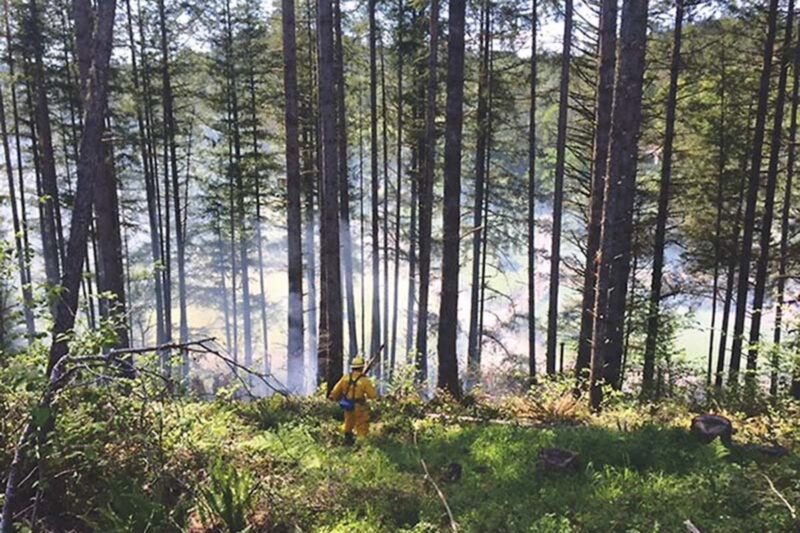Sean C. Morgan
Oregon Department of Forestry officials say now is the time to finish preparing for fire season.
Sweet Home Unit Fire Protection Supervisor Chad Calderwood said people should get their debris burning done now and clear fuels from around their homes.
“This year’s been unique,” Calderwood said. “Our leaf litter did not decay.”
Also, he said, the Sweet Home area also has not had a lot of rain so far this year. As of May 17, the Sweet Home unit had measured 26.49 inches for the year. Last year, at the same time, the measurement at Foster Dam was 23.76, well below the 35.49 recorded in 2017.
Forecasts and moderate drought conditions lead Calderwood to expect above-normal fire risk moving into the Willamette Valley in July.
“A heavy crop of grasses and fine fuels will develop in August,” he predicted.
Fine fuels generally consist of grass, pine needles, tree moss or small twigs that can easily ignite.
Fire season usually begins in late June or early July. The annual fire ban usually begins in mid-June.
“Get your burning done now,” Calderwood advised. “Don’t wait till June.”
The Sweet Home Unit has responded to seven fire calls in the past couple of weeks, he said. Six of them were debris fires, and one was caused by a power line. Inside the city limits, ODF assisted on a fire resulting from an abandoned campfire on Green River Drive.
Among the rural fires was a debris burn that escaped in the Upper Calapooia area due to changing weather conditions, Calderwood said. Another was an escaped debris fire in the Scio area.
A debris fire escaped in the Santiam Terrace area and burned less than a quarter acre, Calderwood said. Elsewhere, a slash fire didn’t escape, but generated a large enough column of smoke to generate a call.
Off Bellinger Scale Road, 30-mph winds dried out and broke snow-damaged limbs, which fell on power lines, causing a fire, Calderwood said. Off Old Holley Road, a debris fire escaped and got into timber.
Firefighters received a report of another fire in the Kingsbury Road area, Calderwood said. Firefighters located a debris fire, but it had not escaped.
In most of these cases, people were burning on a burn day but weather conditions changed, Calderwood said.
“The message here is people are burning, and the conditions are changing.”
In most of these cases, humidity levels were in the 20s, and an east wind was blowing, he said. Even green grass has been burning.
When fire watches and warnings go out, Calderwood said, people need to check their burn piles, even after they appear to be out.
Weather apps will alert smartphone users to watches and warnings, Calderwood said. They are usually issued in the spring and fall when fire managers observe conditions that are highly unfavorable for burning and may lead to dangerous wildfire.
A “fire weather watch” is issued when officials observe potentially dangerous fire weather conditions occurring in the next 24 to 36 hours and a “red flag warning” when conditions are expected in the next to 12 to 24 hours.
Warnings go out when 10-hour fuels – those one-quarter to 1-inch in diameter – have 8 percent moisture. The parameter describes how much water is held by small vegetation, such as grass, leaves and mulch, which take about 10 hours to respond to changes in conditions.
Additional criteria include sustained surface wind of 20 mph and relative humidity of 25 percent o less for several hours. Relative humidity describes how much water is in the air relative to the temperature of the air.
Regardless of fire warnings, people burning debris should keep an eye on weather conditions and avoid letting “fire become the neighbor’s problem,” Calderwood said.
In the rural and rural-urban interface, property owners should clear fuels around their buildings, he said. Inside the city’s urban growth boundary, fire officials recommend clearing 50 feet around buildings. In more rural areas, property owners should clear 100 feet.
“Give your property a fighting chance,” he said.
Sweet Home has brought on three firefighters to help out with fuels reduction. One is working with a juvenile work crew on fuels reduction projects.
The rest of ODF’s local firefighting crew will come on later next month. The annual fire school is scheduled for the week of June 24.
Southern Oregon has had fires popping up and has already hired crews, Calderwood said.
For help and advice with fuels reduction, call the Sweet Home Unit at (541) 367-6108.





